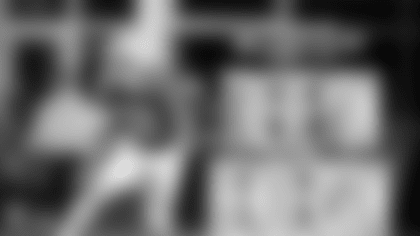**
BB: **As we're getting into Cincinnati here, this is team that has a lot of explosive players, very dynamic players. Defensively, their front is outstanding. Really, they do a great job pressuring the quarterback; do a good job stopping the run. They're very athletic, they're quick, they're hard to block. The linebackers do a good job, make a lot of plays there: [James] Harrison, [Rey] Maualuga, [Vontaze] Burfict. Pretty experienced secondary - pretty experienced defense all the way across the board, up front, at linebacker and safety - they've played together for a while, most of them in the same system. It looks like they're well coordinated, know what they're doing. Offensively, big, strong offensive line, very good skill players, good tight ends, good receivers, [Giovani] Bernard has been a very dynamic back for them early in the season. Of course, we know the type of toughness that Benny [BenJarvus Green-Ellis] has. They're solid in the kicking game, [Mike] Nugent is an excellent kicker. It's a good team, well balanced, well coached. They have a lot of good skill players and they present a plot of problems in all three phases of the game.
Q:How would you compare A.J. Green's skill set to the receivers you just went up against, Julio Jones and Vincent Jackson?
BB:I'd say Green is as good a pure route runner as we'll see. He's a very good pure receiver: quick off the ball, creates separation, excellent timing, judgment on the ball, good deep ball receiver, good third down, red area receiver. He's big but he's not the kind of powerful guy, Julio Jones or Vincent Jackson, but his quickness, his ability to separate and get away from people is outstanding and his ability to go up and get the ball is very good too. Those other guys are big, strong guys that can go up and get it with good ball skills. He has that same kind of size, but I'd say it's a different type of athleticism. He makes some really spectacular catches, like Lynn Swann-ish.
Q:Can you characterize Kenbrell Thompkins' development through the first four games?
BB:I think it's hard to separate the four games. I think really his development has been steady since the day he got here, going all the back to the weekend following the draft when the players came in and all the way through the spring, training camp. KT has been a real steady worker out on the field, every day working hard, always really trying to compete and improve. He's got a good skill set, his work ethic, his competitiveness, his toughness, all those things have been good and they just keep getting better every day. I don't think it's any one thing, but he's improved in everything: his technique, his understanding, his adjustments, the running game, the passing game. We've asked him to do some different things and get him some different responsibilities and he studies it, learns it. If he makes a mistake, he corrects it and comes back and gets it right. He's done a good job.
Q:What needs to be working defensively to have success once the offense gets inside the red zone?
BB:I'd say really pretty much everything. You're playing in close quarters and so every yard, every inch really, is important. The plays happen very quickly, you don't see a lot of slow-hitting, delayed-type plays. You see runs that attack the line of scrimmage quickly, passes that could be very quick, like slants or fades or quick combination routes with receivers, seams down the middle or whatever it happens to be, but plays that really hit fast so you have to get to your spots, your areas, your man. You have to recognize things quickly and react quickly down there. So does the offense - it's just a game now in a much smaller space than what it is when you have the ball out there at midfield, for both sides. I think those are some of the key points. Obviously you have to tackle well because every couple yards down there is percentage-wise a lot closer to scoring than it is out in the field. Fighting for the yards when you're tackling, knowing where your help is, knowing where the goal line is, where the end line is, where the sideline is, trying to use your leverage and make throws tough and defend what you have to defend and use the sideline or your defensive personnel help, I think all those things are a big part of the conversation.
Q:Can you speak to the consistency you've gotten from Stephen Gostkowski and Ryan Allen in the kicking game?
BB:It's been pretty good, it's been pretty good. Those guys spend a lot of time together, of course with Danny Aiken. They've done a good job. We've had a lot of situations come up as usual but a lot of situations come up so far during the season that make each kick kind of a little bit different, a lot different than just standing out in the driving range hitting balls. It's being able to do all the little things. They've done a good job on that. Our coverage units have, we haven't had to cover a lot of kickoffs but our punt coverage units and the couple kickoffs that we have had to cover, they've been solid as well. Given us good field position when we're backed up, Ryan has done a good job of that. Of course, Steve has done an excellent job with the kickoffs giving us field position in that area too. It's all been positive.
Q:In general when you've moved to a different style of defensive play and been in so much sub-defense, it seems like you've started to draft guys who can move side-to-side. Do you look at that group as it's still an ever-changing philosophy and you have to have many different types of players and Vince Wilfork was an anomaly because he was a space eater and was quick too?
BB:I think that's an interesting question. From week to week, you face a lot of different challenges and a lot of different offenses in this league. Trying to find the right matchups, of course it's easy when you have a player that's really good at everything. It's a little bit harder when you have to find somebody, work different combinations of players that maybe excel more in one phase of the game than others. But facing teams that are two-back, power running teams like the Baltimores of the world versus a team like Atlanta last week that we were in sub-defense, most of the entire game other than a handful of plays. Now we're seeing teams like San Francisco last year, Buffalo this year, Philadelphia in preseason and I'm sure there will be a little more of that trend in the league that the running game is more of a sideline-to-sideline running game as opposed to the traditional what we've seen for years out of even two-back or two-tight end teams that double team, power block, pulling guards and stuff like that. Over the course of the season, you're going to have to deal with all those things. As soon as your opponent sees you're not very good at one thing, you can expect to see a whole lot more of that. That's what they do if they have it. That's kind of the challenge, is to have enough depth and variety in your defense to be able to match up to those different type of offensive systems and be able to compete with them. It's like one week you're going up against, like I said, a team that has four or five really good receivers, the next week you're going up against a team that has a couple really good tight ends, another week you're going up against a spread running team, another week you're going up against a power running team, one week you're going up against a running quarterback, another week you're going up against a real accurate, pocket-type quarterback. You get receivers that are great downfield, deep receivers and you'll get receivers that are underneath, quick, very good maneuverable guys. Those are all the challenges. Like I said, if you have one player that can kind of do pretty good in all those situations, that's great. The guy is probably going to be one of the top draft picks and highest paid players in the league. After that, you're trying to put everything else together from a scheme standpoint and from a player standpoint to match up to that week to week. That's definitely a challenge. Trying to find the right players and the right overall composition of your team is challenging. Whereas, on the offensive side of the ball, you have control over the ball. You know who you hand it to, you know who you throw it to, you determine what kind of formations you want to get into, how many guys you want to put on the field that are receivers or tight ends, or where you want to put them, if you want to throw the ball quick or throw it deep or run behind double team blocks or option run. You control that. When you're on the other side of the ball, you don't control anything. You have to defend what they do and it's a much different problem.
Q:Does Armond Armstead's situation prohibit him from helping the team this year?
BB:That would be up to our medical staff. We'll just have to see how that goes as the season continues to develop here. We'll just have to see how his situation is.











































